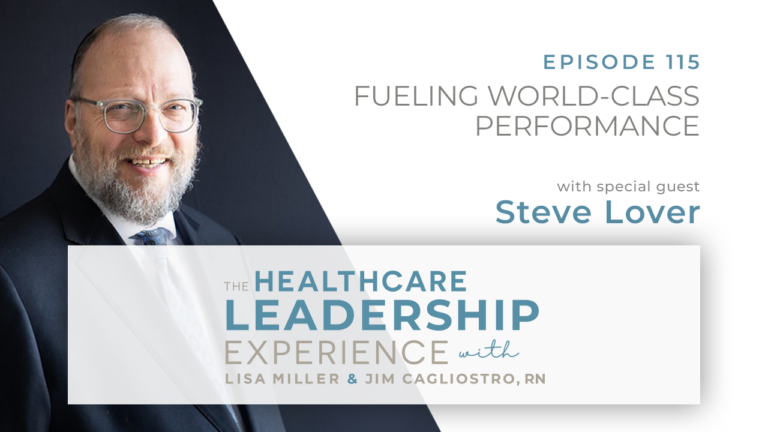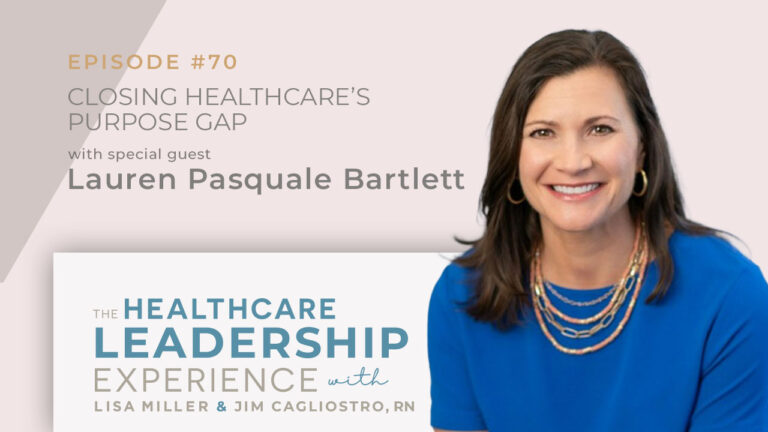In Episode 19 of The Healthcare Leadership Experience, Lisa is joined by her producer, Lisa Larter of The Lisa Larter Group. Together they discuss the role that cost awareness plays in patient care and the need for positive operating margins in healthcare.
Lisa notes: ‘’It’s a huge myth that most hospitals are making lots of money.
This episode is sponsored by VIE Healthcare Consulting® which has proudly helped hospitals save $758 million since 1999.
In today’s episode you’ll hear:
The common misunderstandings around hospital revenue and cost and the need to develop a cost aware culture.
Learn about VIE Healthcare’s Cost Aware For Patient Care program and the importance of educating employees on a culture of cost awareness.
How a $1 billion net revenue doesn’t necessarily equate to positive operating margins. ‘’Probably 70-80 percent are operating in negative margins.’’
The seven skills essential for margin improvement:
Open communication: Why an employee suggestion system is not the solution, and the parallels hospitals can draw from the TV show ‘’Undercover Boss.’’
The need for constant observation – coupled with some unusual inspiration from Tony Robbins’ Business Mastery program.
The key role that data analysis plays in the financial success of a hospital. ‘’You can take the emotion out of all this work because the data speaks to the facts.’’
Negotiations, including the direct correlation with profitability and why no hospital should ever negotiate alone. ‘’…hospitals are being out negotiated every single day by their vendors.’’
Why every hospital leader should question their own decision making process (Hint: quick decisions aren’t necessarily great decisions).
Why every hospital needs a project management system in place and why VIE Healthcare® completes every project within 30 days.
Monitoring and measuring: ‘’The reality is that this is about patient care.’’
Listen to Episode 5 with Dr J J Peterson – The Patient Is The Hero Of The Story for more on patient care.
To learn about VIE Healthcare’s Cost Aware For Patient Care program, reach out to Lisa at lmiller@spendmend.com
CLICK HERE TO DOWNLOAD THE PDF TRANSCRIPT
Connect with Lisa:
📧 lmiller@spendmend.com
📱https://www.linkedin.com/in/lisamiller/
CLICK HERE TO OPEN THE FULL TRANSCRIPT
Lisa Larter (00:00):
So it’s a huge myth that most hospitals are making lots of money?
Lisa Miller (00:04):
It’s a huge myth. And if somebody’s looking at their overall margin, and they see, maybe they’re in the positive, but if they look deeper… So now they have investments, fundraising, or other revenue sources, and they say, “Look, they’re making just a ton of money.” The reality is, just like you and I, we have to make a margin in our operations. That should be the goal. And great, fundraising and all those other things like investments are security, capital… Just all other reasons why you would want that. But the goal is to have a positive operating margin from operations. That’s key.
Speaker 3 (00:44):
Welcome to The Healthcare Leadership Experience, a place where healthcare leaders will share proven strategies and innovative approaches to leading the clinical and business side of healthcare. This show is sponsored by VIE Healthcare Consulting, who has proudly helped hospitals save over $700 million in non-labor costs since 1999. Here is your host, Lisa Miller, founder and CEO of VIE Healthcare.
Lisa Miller (01:07):
Hello, this is Lisa Miller with The Healthcare Leadership Experience. And I’m here again with Lisa Larter, who’s our show’s producer. Welcome, Lisa, to a discussion about Cost Aware For Patient Care.
Lisa Larter (01:19):
Looking forward to it.
Lisa Miller (01:20):
That’s great. So, there’s a lot of misunderstanding, I believe, about hospital cost versus revenue a hospital makes. So, over the last 22 years when I’ve been working with frontline team members in hospitals and talking about costs, a lot of times I’ve heard things like, “Well, it really doesn’t matter, you know. We get paid by case,” or “We get paid by a bundle.” And I continue to hear these things through today.
Lisa Miller (01:49):
And, you know, I know that hospitals talk about cost savings and margin improvement, but I think there’s a big misunderstanding thinking that hospitals make a ton of money. I hear that, ugh, I hear that so much from vendors, but I hear it often. And it got me thinking, like, okay. How do we support hospitals in, you know, bringing in together, their people, and making them have a cost aware culture? And for the goal is for patient care. They’re not doing this for any reason. No one’s doing this for any other reason other than to support patients, support the physicians, and the clinicians, and their communities.
Lisa Miller (02:29):
So, we came up with a program called Cost Aware For Patient Care. And we’re not gonna talk a lot about that program, but talk about the fringe. The,you know, why it’s so important that we have to give our team the, the employees at the hospitals, a big vision to see the opportunities, all the opportunities, while giving them an understanding in the marketplace so they can be contributors in their hospital’s success. So what does that mean?
Lisa Miller (02:58):
You know, the marketplace is very complex, right? So we have suppliers, GPOs, manufacturers, distributors… There’s just all these different people, organizations, that are part of, in the mix, as it relates to cost. And you know, some costs are, unfortunately, they’re in silos. Some costs are, you know, outsource physician agreements. So the physicians are providing like ED services or anesthesia services. So, you know, there’s, there’s all this complexity. And hospitals really have to be, I don’t wanna say transparent, but be educational in explaining to people… And frankly, there’s some directors, and even some leaders, who I don’t think understand fully the cost equation as it relates to the whole marketplace, right?
Lisa Miller (03:45):
You know, distributor mark ups, pharmacy potentially having a, a cost minus structure, or all those other things that relates to services. Services are performed, then invoiced. Well, what does that mean for the organization? You know, who does our auditing of contracts? We don’t know… What are internal controls? Or what does the marketplace do? What’s going to happen in 2022?
Lisa Miller (04:07):
So this idea of education and pushing out education into their organization about, at least on the cost side, is so key. How costs map to reimbursement? Yes, Medicare gives specific DRGs, you know, for in-patient cases. You know, managed care companies maybe make a little bit more, but these days, maybe not so much. But how does that work? Because you want them, again, to be contributors in this process, for the organization’s success.
Lisa Miller (04:37):
So as I mentioned earlier, we have a program called Cost Aware For Patient Care. And it starts with a presentation to leadership first, on hospital costs. We have a really great deck, and we go through the market, and the shifts, and, and where those opportunities are. And really understanding how, really, everything starts with a cost. But what does that mean from an item all the way through to billing? And it’s a great presentation to have at a leadership meeting, I know, ’cause it really starts people thinking in, in ways that, they, uh, have a different level of understanding so they can make changes, or they can seek out new opportunities.
Lisa Miller (05:12):
Then we work with directors and all employees on presenting that Cost Aware presentation. And it’s all about educating the organization on costs, and giving them insights, they otherwise wouldn’t… And it, it’s not because anybody’s lacking, but it’s just being able to put this in a framework that gives them the education. And once someone’s educated, I mean, they’re never gonna go back. They’re gonna see things differently in that light from then on. So, we’ve had some great success with making those presentations because it’s the entry point to better discussions, better thinking.
Lisa Miller (05:44):
And you know, there’s seven skills… And there’s probably more, but you know, for the purpose of this show today, I think those are the seven skills you need for margin improvement. Absolutely-
Lisa Larter (05:55):
Before you dive into those seven talking points, I, I have a couple questions for you. The first question that I have for you is, in the years that you have been doing this, which I know… Since 1999. So you’ve been in this game a long time. What percentage of hospitals do you see making a lot of money? Versus hospitals that are losing a lot of money because they’re not being charged appropriately.
Lisa Miller (06:17):
It’s a really great question, so I’m gonna answer it in two ways. One is, I’m doing some research now for a report, like an executive report, which may turn into a little, skinny book. I’m not sure. But it’s analyzing hospitals who have a billion dollars in net patient revenue.
Lisa Miller (06:35):
And I wanted just to understand, you know, from their Medicare cost report, are there any uniquenesses? Is there anything I could see? So these u- I think there about, we’ll say 300 hospitals or health systems that make over a billion dollars, a billion dollars or more, in net patient revenue. So that’s a very unique sub-specialty, you know, in the marketplace. And I wanted to see if they did some things differently.
Lisa Miller (06:57):
So what I found, and I don’t have it right in front of me, but was interesting… It was three buckets, right? So there’s high performers, you know, the average, and then kinda lower performers. But I would say out of the 300, I believe there were only, like 114, that… Out of operations, not from any other income, so out of operations, were in a positive. And that positive, you know, they had some that were higher, but there’s some that were, just squeaked in at, like, 0.01%. And then you know, you have the, um, middle tier and the low tier.
Lisa Miller (07:32):
So it was fascinating, and I still am going through the data because I wanna point out that a lot of these, even in the, in the billion dollar club we’ll call it. A lot of them, most of them I would say, probably 70 to 80%, and I think this goes through the marketplace, from their operations, are operating in a negative operating margin. And they make it up in other ways, fundraising, or other outside investments, or even outside ventures.
Lisa Larter (08:00):
So it’s a huge myth that most hospitals are making lots of money.
Lisa Miller (08:04):
It’s a huge myth. And if somebody’s looking at their overall margin and they see, you know, maybe they’re in the positive. But if they look deeper, so now they have investments, fundraising, or other revenue sources. And they say, “Oh, look. They’re making just a ton of money.” The reality is, just like you and I, we have to make a margin in our operations. That should be the goal. And great, fundraising and all those other things like investments, are you know, security, capital… I mean, it’s just all other reasons why you would want that, but the goal is to have a positive operating margin from operations, right? Operation margin. And that’s key. It really is a myth.
Lisa Larter (08:45):
And then my second question, you talked about your Cost Aware For Patient Care program, and how it starts with a presentation to leadership. Do you do a presentation to leadership before they actually engage your services for the program? Or is that presentation part of the program?
Lisa Larter (09:04):
And then my follow-up question to that is, how does a hospital know when they should engage you for a conversation about this? Like what would be some of the things… If I’m listening to this show right now going, “Oh, that Cost Aware program sounds interesting.” Like what would qualify me to reach out to you and say, “Can you tell me more about that?” What would I be thinking about?
Lisa Miller (09:27):
So this program was created, like, outside of our typical services. Our typical service is supporting hospitals in their cost savings goals, initiatives, analytics, you know, just all kinds of cost projects, right? And so, this was kinda created outside of that because years ago, I had seen a presentation from a company that came in and talked about the marketplace from the revenue side.
Lisa Miller (09:51):
And I thought it was a really great presentation, and we love growth… You know, everybody loves growth, innovation, new markets… And, and really that was what the presentation was about. And it’s super exciting. And in the back of my head I thought, well, we need that same version of that for costs, right? And you know, it doesn’t make sense to grow… I mean, growth is important, expansion’s important. All those things are strategic. But if you’re growing a service line that has a negative margin, or a minimum margin, or not capturing all those opportunities for that new growth, it seems like that’s misplaced a little bit, right? It doesn’t seem like it’s as useful as it could be. It’s optimization versus innovation.
Lisa Miller (10:34):
Both are important, but I would rather have my spend optimized before I decide to grow, grow, grow, grow, and be growing a negative problem. So this program is meant to be added… Is, let’s say, you know, we, we now do it virtually. But it’s meant to add as a part of, you know, could be a monthly leadership meeting they have. And we, you know, it’s about, uh, 90 minutes. And you know, we’ve got a great deck, and information, and we make it also somewhat interactive. So, it’s separate, right? It’s a pure education. It’s meant for educational purposes.
Lisa Miller (11:07):
And so somewhere would know that they needed that, I believe, they see their cost increasing. Or they’re feeling like there’s not a lot of opportunities. They’re feeling like there’s maybe not a lot of support. Or they, they just wanna rally the team. They, they wanna have a great kinda team meeting. And this is a great way to make it educational. So, I think that’s the first part of your question. Versus an organization that might bring us in for a cost savings initiative.
Lisa Miller (11:33):
And I think it, it’s around a couple things. I think if you’re seeing some of those budget areas increasing… If they have a big contract coming up and they, they wanna hit it out of the park, right? We come in, and we work together. But if they got a big contract coming up — whether that’s on the cost side, or even as we support data analytics on the managed care side. If they just, if they want someone to come in to analyze the data, benchmark, give them a strategy, and provide negotiation services.
Lisa Miller (11:58):
Sometimes you have hospitals that, you know, I give them a lot of credit. They just wanted us to help with negotiation. They want us to be there with ’em, behind the scenes, together with ’em. And some of the biggest organizations have hire- and in business, they hire a negotiation team. ‘Cause you want a team of people if you’re, you know, negotiating a multi-million dollar contract. Some of these contracts are eight figures over the course of years. And, and if a hospital has a plan for the future, and they really wanna gear up, and they… You know, they kinda wanna look at their costs now, to maybe be part of that funding, it, it’s another great opportunity. And I think second opinions really matter. We talk about in our next episode, you know, reasons why. Thank you for asking that question. (laughs)
Lisa Larter (12:43):
So if someone is interested in that presentation that you do to leadership on hospital costs, should they just contact you directly?
Lisa Miller (12:52):
Yes. Yes, yes, yes.
Lisa Larter (12:54):
Awesome.
Lisa Miller (12:54):
What we’re going to be talking about it more in the marketplace, and social media, and… It, it’s kinda been a little bit under the radar to our current clients, and we’ve written about it a little bit, but we’ve gotten great feedback. But it’s a great way to rally around a topic, and for everyone to be aligned. And I think the subject that keeps on coming up for us as a topic… I didn’t know that. I didn’t know that, Lisa. It’s a great point. I, I’m, my, my thinking’s been shifted…
Lisa Miller (13:21):
And that’s the nice part about it. Because the giving education from… In some cases, we pull information from JAMA, from studies, and we’re giving a lot of factual, deep research, right? This isn’t like Lisa Miller coming out and putting together a framework. And we do have a framework, but it’s built on tremendous research. And we pull it together, and, you know, they really enjoy it. And it does become a shift in the way they think.
Lisa Miller (13:48):
So hence, you know, why we’re talking about Cost Aware For Patient Care, because this is all about patient care. You know, just because you’re looking for cost savings, doesn’t mean it has to impact patient care. In fact, it’s the opposite. These initiatives are meant to increase the quality of care, increase services, expand services. So, as we look at these seven skills, you’ll need for margin improvement…
Lisa Miller (14:13):
Number one is open communication. It’s the ability not to have, um, an employee suggestion system, right? An idea, you know, where people write down ideas, which is great. Uh, you know, I, I think those things are, are good, but it’s linear. It’s flat. It’s typically one-way. But when you have an open communication… You know, that’s the ability for somebody who’s working to clean the rooms to be able to feel confident enough to say, “I have an idea. Could I reach out to someone from finance ’cause I, I wanna understand how I can put this together?”
Lisa Miller (14:47):
And how comfortable is the organization with somebody who will be cleaning the rooms to reach out to finance, and maybe they’re a department director, not getting upset because they did that — or afraid of what they’ll look like because they didn’t bring it up. Who, who knows? Do we have the ability to really have everyone engaging, everyone is on the, uh, same, same value?
Lisa Miller (15:09):
I love that show Undercover Boss. So, on my list of things to do is to write more about this Undercover Boss and, and the parallels or the opportunities for hospitals. So, wouldn’t it be amazing if a hospital CFO or CEO went undercover and worked in food services or EVS? I’ve seen where they’ve kind of, little bit, where a CEO might do a job for an afternoon… ‘Cause I’ve seen some of it on social media, which is really cool because I think that the CEO even putting themselves in that place to, you know, clean a room, to serve food, or to do transport, is awesome. But what if they did it that they were completely undercover, right?
Lisa Miller (15:51):
The CEO said, “I wanna do transport services for the day. I wanna understand.” ‘Cause transport will allow them to see, really, the whole hospital, but do it undercover. What would happen? Like, what would they hear and see? What would they talk about? Like, what would those transport professionals or employees say about their leaders, leadership opportunities? I would love to see some of the leadership kinda do an Undercover Boss in healthcare and see what would happen.
Lisa Larter (16:17):
That would be really cool, and I bet you they would learn a lot.
Lisa Miller (16:21):
Yeah, they would learn a lot. Because the idea is that they are seeing things in the frontlines, but they’re talking to frontline people that don’t know who they are. And they’re doing it in such a way that they’re gonna garner just amazing insights, and opportunities, and hear… Like, do we have an open communication? What’s going on there? So there’s just a lot of cool ways that you could have open communication, but that’s number one.
Lisa Miller (16:45):
Number two is the idea around observation. So, observation is really important. You know, two people can be sitting at the same location and observe two different things, right? And so you almost want to be aware of what you’re observing. There’s an exercise that I’ve done, it’s actually a video, one of Tony Robbins’ business mastery programs, where he tells everybody… He has, puts a video up, and there’s two different teams. And he tells ’em, “Okay, count how many times a ball is passed from the people in the white shirts to the yellow shirts.”
Lisa Miller (17:21):
So everyone’s counting how many times it’s passed. And so everybody’s like, 4, 7, 18, 15, you know, whatever number. And, and there is a number… And he does it again, but what people miss is, there’s a gorilla that walks through the people passing the ball. And most people miss the gorilla. And he stops. He goes, “Who saw the gorilla?” Like, there’s a… Literally, gorilla costume, someone in a gorilla costume walking through and people miss it. (laughs) Isn’t that crazy?
Lisa Larter (17:45):
I’ve seen that video. It’s crazy that you actually so focused on one thing that you miss the bigger picture. That’s such a great metaphor for why we need to be keen in terms of our observations.
Lisa Miller (17:58):
Yeah, I mean, so like… You know, I was putting this together… I’m like observation. And they’re gonna be like, “Okay, Lisa, really? So one of the skills you need is observation? Like, that’s how you begin?” And it’s, yes, because of that gorilla costume story.
Lisa Miller (18:12):
And they have another video, which is really fascinating. And, and if anyone’s interested, I could kinda point you to where it is. Where there’s two people doing this, like, you know, magic tricks with the cards. But what they… They’re watching it. But what they don’t realize, they like, the people take off their jackets, the background is changed. And all the things they do, and you don’t see it till the second video. And then you’re seeing them change their shirt, or take their one top off, and now they went from a black shirt to a white shirt. The scenery changes…
Lisa Miller (18:39):
And it’s true. Like, observation is so important. And you know, the reality is, you can train or educate about slowing down to be able to observe. Be aware, look for opportunity. So that’s the second.
Lisa Larter (18:54):
Isn’t it a Wayne Dyer quote, that when you change the things you look at, the things you look at change?
Lisa Miller (18:59):
Yeah, absolutely. And again, in preparation, I thought, to me, it’s so important because we have to choose to be conscious and aware. And you know, I think you’re gonna get a different, like you said, different outcome, different reality.
Lisa Miller (19:14):
So now that we, you know, talked about those two, maybe softer ones, which I think are very powerful. That’s why I listed them as one and two. We’ll go into some things that people probably have heard of (laughs) more frequently. And the third is data analysis.
Lisa Miller (19:28):
And I talk about it a lot because data analysis impacts hospitals everywhere. It impacts the way we analyze outcomes from discharge, to readmissions, to social determinants of health, to managed care, to cost… There are probably 100 plus different ways that data analytics could be used for healthcare performance. And a hospital really should be having a list of all the things that they are utilizing data analytics for on a regular basis, for their outcomes. And I think it’s under-used or it’s used spotty. There’s a lot of assumptions, you know, that are unfortunately being made. Like, “Oh, yeah. We’re doing that. We’re analyzing our clinical costs.” And maybe some things are re-done, or maybe the OR does it sometime-
Lisa Miller (20:13):
OR data analytics is key to the overall financial success of a hospital. So how are you using data analysis? And it’s not the platforms, it’s the analysis. What are you getting out of that analytics? In fact, there’s probably a lot of platforms you’re not using you should get rid of. (laughs) You know? And really size down, and use tools, you know, that may be agnostic. Like Power BI, and pulling in, data into a platform like that, and, and really analyzing your data. I’ll give you-
Lisa Larter (20:45):
Can you give us an example of a data analysis that you did for a hospital that was shocking to them?
Lisa Miller (20:52):
Yeah, so I think that the one that comes to mind is, it’s, um… There’s a lot, but there’s one that I think may be useful for everyone. I think, you know, in terms of orthopedics and implants spend, you know, there’s been a lot of focus around, uh, capitating, let’s say a total knee implant. So capitation means that, you know, there’s one price for all the implants for a knee replacement.
Lisa Miller (21:17):
So you go in, you need a new knee replacement. This is a big part of the hospital costs, so they’ll capitate it. They’ll say, you know, let’s say for a, a high-performing knee, and I’m just… This is arbitrary. It’s, uh, $3,000, right? High-performing knee, it’s $3,000. We’re gonna capitate that rate. That’s all-inclusive, all in. And everyone’s like high fiving. We got the best rate. There’s – nobody’s gotten better rates than us. You know, uh, we’re awesome. And it’s great.
Lisa Miller (21:43):
You know, $3,000, high-performing knee, everyone’s happy… Best in class, plus. So then over time, the vendors start, you know, changing things and bringing in a different component into the capitation, right? And so everyone assumes that component’s part of the capitation. So they’re just using a component. Or that there’s been some sort of price adjustment because maybe they’ve used a revision component, you know, a different component ’cause the patient maybe has issues with their bone, or weight, whatever. And that’s being, adjustments being made.
Lisa Miller (22:20):
So, we recently had a hospital, who really, they did a fantastic job at their knee implant capitative cost. But what had happened was, that the vendor was bringing in a, a new component, and that component was not included in the capitation, adding $1,400 to the case. And the hospital wasn’t aware of it. You know, because they didn’t back out the one component, we argued they should get a credit, which they ended up, did getting a credit.
Lisa Miller (22:52):
And so you know, I would say, say call it, $700,000 spend, and they had a nice job with the capitation. And you’re looking at more than a 30% cost savings, and a credit, we’ll call it like, uh, close to, uh, $100,000 in credit. And for an organization that, um, again, running in, in a negative operating margin, thought that everything was taken care of. I mean, in fact, they were like, “You don’t need to look here, we just did this. It’s fine. You know, we have capitation.” And we’re like, “Well, it doesn’t cost us anything to look at it. Let’s just take 12 months of data, and let’s just run the analysis.” And they were shocked. They were completely shocked.
Lisa Miller (23:30):
And I’ll give you one more story on that same note. We had a physician who… We were doing the same… This is a large health system. And we were getting all the physicians aligned with capitation. And we started talking about revision components. A component that costs more and how it was used. And he’s like, “I only use this, like, 7 or 8% of the time. That’s all I use it.” Very specific cases. And we said, “Well, actually, the data shows that you’re using it over 37% of the time. You’re using this revision component.” He said, “What?” He’s like, “I…” He had no idea. Data showed something completely different than what he thought he was doing and thinking he needed. He’s like, “That’s way too much.”
Lisa Larter (24:09):
Yeah. We assume, when we don’t have data to support our assumptions, right?
Lisa Miller (24:13):
Yeah, absolutely. But I feel like sometimes the assumption is so strong. Like, you know, no, no… You know what? We’re not doing that. I’m only doing that little bit. No, no, we got that covered. And it’s pretty interesting to see, not just a little bit of variance. Sometimes it’s just a huge variants into some of the assumptions that are made. And I think that’s the biggest opportunity, is…
Lisa Miller (24:31):
I often say to my team, sometimes to hospitals, you can take the emotion out of all this work because the data speaks to the facts. You know, so I don’t have to get… How should I say it? Worried about what a physician might (laughs) say, or someone might say, or be offended that the contract was just done and there’s still opportunity. I mean, the data’s gonna speak for itself. And you know, you, all you can do is, you present the data, show the opportunities, but, um, we need to use data a lot more, and a less on gut… Uh, less on reactionary, uh, less on assumptions. ‘Cause I think that’s an important skill.
Lisa Miller (25:07):
So negotiations… It, it’s such an interesting area because I feel like that’s an, a big untapped opportunity for hospitals. So I wanna take a step back… Hospitals, your vendors get trained in negotiations probably once or twice a year. In fact, if you were to Google vendor negotiation or manufacturer negotiation, you- there are companies that all they do is provide negotiation services for vendors to help them increase their margin.
Lisa Miller (25:38):
I have those resources. I’ve been on their site. I, in fact, I’ve been on some of the trainings. I don’t say this to be mean-spirited or… I say this hopefully to awaken and alert people, but hospitals are being out-negotiated every single day by their vendors. And it is to me, one of the biggest opportunities that hospitals need for margin improvement.
Lisa Miller (26:03):
Negotiation is… You have entry level, mid-level, advanced… You have people who have been negotiating for the FBI. There’s a great book, Never Split The Difference. I encourage everyone to read it. Once any of my customers tell me, “Lisa, just split the difference, we’ll be good.” I, I cringe… I’ll do whatever they want, but I’ll explain why that’s not a good idea. And it’s not that you want them, anyone else to lose, it’s just, it’s just not a great strategy.
Lisa Miller (26:30):
So, negotiations require you to have such a solid base of your agreement, you know, pricing, or what, whatever you’re negotiating. Could be managed care, could be negotiating with physicians. But for you to have a solid platform to know what are the things that are important? What are those drivers? And then to have a strategy. And to understand that you probably need a team. You probably need one or two people, but you at least need a negotiation buddy.
Lisa Miller (26:55):
I mean, if you wanna be in a high-performance situation, don’t ever do this alone. And if you, if you feel like you could do it alone, you’re not gonna get the best outcome.
Lisa Larter (27:03):
It’s amazing how people are afraid to negotiate. They’re afraid to ask for a better deal. They’re afraid like, I don’t know what it is that makes us human beings uncomfortable when it comes to the actual skill of negotiation.
Lisa Miller (27:17):
Yeah, I mean, I agree. I think it’s two things. You have some people, and I think it’s the lesser… That just feel that they’re just great negotiators. They just feel like they can do it on their own, they don’t need anything, and they can just negotiate. And, but the vast majority of people do not like to negotiate. And they’re not always truthful about it. They’re uncomfortable.
Lisa Miller (27:37):
Vendors, again, are really skilled. They’re doing things like they’ll circumvent situations, circumvent to the doctors, to a higher authority. They make it very uncomfortable, or they’ll… They have strategies, like, uh, we’re losing money. This isn’t fair. This doesn’t exist. I mean, they deploy a lot of strategies, and it works. And to your point, I don’t know what it is, but just the simple ask. I think… We do a negotiation training program. And one of the first things we talk about is, the biggest problem is that people just don’t even wanna ask. (laughs) I mean, it’s as simple as that. It’s like up there on the list.
Lisa Miller (27:37):
Yeah, people are too attached to the outcome. They take it personally if they ask and they don’t get what they asked for. And so, then they avoid it because the first time they did it, they weren’t successful.
Lisa Miller (28:24):
It’s true. There’s a, there’s a lot of psychology around negotiations and just asking — and being okay. Being okay with getting rejection. Or being okay with, maybe you get the rejection the first one or two times. I can’t tell you how many times that we get “no” the first time. I’m like, “Okay, well, we’re gonna show you.” Like, we just didn’t pull this scenario number outta thin air, and we’re willing to keep this going, and back it up, and continue. Because you get no does not mean failure in negotiations. That’s why having a strategy is so important.
Lisa Miller (28:55):
That’s a great point, Lisa, about us being uncomfortable with asking. So negotiation training, I mentioned this before, but there’s a study that was done, it was in businesses… I believe it was like the Fortune 1,000. And those companies that have a systematic negotiation process versus those who don’t. The difference in profitability, I believe it was almost like 14%.
Lisa Miller (29:20):
So negotiation has a direct correlation with profitability. If you think about all the contracts your hospital has… So whether they’re on the cost side? Expense… I’m sorry, the reimbursement side. Whether it’s with a JV agreement. Anything that, any contract you have, negotiation can be tied to the profitability or in financial outcome. So the better you become at negotiations and the better you’re willing to sometimes slow down, have a plan, want a negotiation strategy, the better your rewards are.
Lisa Miller (29:50):
Number five, it’s decision making, critical thinking, and what Keith Cunningham calls thinking time. So it’s kind of a combination, but we have to be able to really push back on our, even our own decisions. So if we have a decision we’ve made, let’s say on a contract, or a decision on a strategy where we wanna go to or present… How willing are you to say, “Is this the right decision? What if this is wrong? What don’t I see? What’s the downside risk?” How are you able to really question your own decision making? And you know, what’s that process like? And, and taking some thinking time…
Lisa Miller (30:29):
You know, it’s taking 20 minutes, a pen, paper, and writing down all those outcomes. And am I making the right decision? Or are there other decisions I’m not thinking about? Is there an “and”? Something I can add to this decision. But we think that quick decisions are great decisions, and in fact, it’s… When you really become aware and question your own decisions, then you become a better decision maker.
Lisa Larter (30:53):
So true. So powerful. And we live in such a multi-tasking, distracted time that is it unusual for people to sit and think about their decisions, and think about what they might be missing.
Lisa Miller (31:07):
Yes. And it’d be interesting what you end up coming with just by having that time and making a list. And it’s just like, and, and, and. And what may end up being a, you know, a correlation or a combination? You know, something different that you might come up with.
Lisa Miller (31:24):
And so number six is project management. This is a skill. Being able to plan a project with milestones, put something together. It could be one or two pages. We use a system called Workfront. We love Workfront. We create our milestones. I can tell you, we have seven milestones to every project we do. By the time we get to milestone five, I can tell you that that project will complete in X number of days.
Lisa Miller (31:51):
We have it pretty well mapped out. And you don’t have to do that to that level. You know, we’re managing so many projects per hospital, and outcomes are important, so we wanna drive to- towards rapid outcomes. So we have deployed a system that manages days.
Lisa Miller (32:07):
Our projects, most projects should take 30 days. And that’s another thing, you know. It’s funny because when we tell a hospital, we tell a vendor, or even some people with the hospitals, this has happened even recently. “We’re gonna finish this in 30 days.” They’re like, “That’s impossible. You’re, what you’re doing is impossible. That, that can’t be.” And I’m like, “Well, no. We can do it in 30 days.” And I’m like, what if, so what if we can’t?
Lisa Miller (32:30):
But we’ve told the vendor, this is what we want. Better then, what? It takes six months. Why do we accept the vendor’s timeline? Why do we accept long timelines? That’s not a badge of honor, to say this project took nine months. It’s way more powerful to get this incredible outcome, and all right, set it for 30, 45, 60 days. But having a project management system in place is really important. Too many people, again, are just… You know, they’re running by the urgent issue of the day, and then they get to a margin improvement opportunity.
Lisa Larter (32:58):
That could be a whole other podcast, just on-
Lisa Miller (33:01):
Yeah.
Lisa Larter (33:02):
Project management. ‘Cause you know, I’m, I’m sitting here listening, and I, I wanna know, what are the seven milestones? Do you have a system around this? How do you do — like, because on my team, my right hand always says to me, “Process equals profits.” And so when you look at processes that are integrated into your project management systems, then it does equal margin improvement opportunities inside of hospitals. It’s the same thing. So I think that would be a great episode to unpack further.
Lisa Miller (33:36):
I love that. And I think one on negotiation as well. But project management, yes. It took us years to get our process down for project management. I have to thank Hector Rodriguez, who really double-downed and made us really focus. And took that initiative… We had a very, we had a good process, and he wanted it to be great.
Lisa Miller (33:58):
And he made it great. And I give him the credit for that. It has been probably one of the leading reasons for our success, having this project management system in place. So I am gonna take you up on that. I’m gonna do a podcast on project management.
Lisa Miller (34:14):
And then, to wrap up number seven, is monitoring and measuring. So we’ve done all this work, right? So we have open communication. We have observation, data analysis, negotiation, thinking time, project management… We do all this work, right? We’ve lined up these six major components. And the areas that require, like, a lot of muscle, right? And then project’s done.
Lisa Miller (34:38):
Put it away. Put it in the drawer. Put the contract somewhere, it’s done. Throw the project away. We, look, we got the savings. We got the revenue. We got the engagement. And it’s done. And then, nobody measures and monitors. (laughs) So, uh, y- (laughs)
Lisa Larter (34:53):
Or they measure and monitor at the end when it’s too late to impact change.
Lisa Miller (34:56):
Well, they measure and monitor right before the re-negotiation. They go, “Oh, wait a minute. This is what happened in month eight.” And that’s exactly what happens. As they’re ready to re-up that agreement, or the analysis, or the area, then, then that’s done. So you do all this work, like… How much work is spent on getting ideas? Getting ’em in place. Getting ’em approved. Getting alignment. Negotiating internal, external, data, project management. All that work’s done, and then we don’t measure and monitor? (laughs)
Lisa Miller (35:28):
I speak about measure and monitoring so much. And funny, and I don’t wanna bring GPOs back into this conversation, but I am for the moment. You know, everyone’s like, “Get on the contract. Let’s get on the contract. Do you wanna be on our contract?” And okay, but who’s talking about the discipline about measuring and monitoring to say, “Hey, look. Something’s off there, month six.” I can’t tell you how many times, you know, we work with our clients, and we finish a project, and then we put it in place, measure and monitoring.
Lisa Miller (35:55):
I mean, not every agreement, ’cause maybe they’re smaller and some things can be done, you know, possibly, you know, ad hoc. I, I think every agreement, or every cost should be analyzed. But you know, we’ll come in and, you know, start that month one, and we’re like, “Wait a minute… That’s not right. That’s not right.” And we capture in month one, or we just see things in month seven. Like, and we capture them in real time.
Lisa Miller (36:16):
And you think about… It’s, it’s not cost avoidance because that would’ve been a real cost. But we’re capturing issues as they’re happening. And we’re protecting all the hard work everyone did. We’re protecting those cost savings. Lisa, you know, you and I talk about cost protection. And then, it gives you the opportunity to dig even deeper. If you’ve got everything you’re doing in place, you’re measuring and monitoring. Now, you get to see other nuances that take your savings even further because you’ve done all this work. You’ve measured, monitored, and now you’re gonna take this to a new level, a deeper thinking, a deeper analysis.
Lisa Larter (36:53):
I think people… Or maybe you can answer this question. I think people lose sight of the impact on the patient care, the patient experience. They look at these skills in isolation of the impact to patient care. Would you agree?
Lisa Miller (37:12):
I absolutely agree. You know, we do talk about it, the business side of healthcare. But the, the reality is, this is about patient care. Right? So the measuring, the monitoring… Okay, it’s probably another thing somebody has to do, but it is about patient care. It is about the margin. And maybe measuring and monitoring should be one department.
Lisa Miller (37:32):
I, and I’m certainly not suggesting that, you adding all these different people, but maybe it is an outsource function? Measure and monitor. Maybe the top 20 agreements need a completely different approach to measure and monitor, and provide the insights going on. I’m telling you, it, it is remarkable what we see when we are measuring and monitoring for our clients. The things that we’re capturing. The… That would have been a big financial blunder, had we not caught that, you know, when you did, Lisa.
Lisa Miller (38:02):
So, uh, you know, it, it’s true. It, all those things would have a patient impact, and I think that’s the problem. We’ve gotta keep on tying those things to patient care, Lisa. You’re absolutely right.
Lisa Miller (38:15):
So as we wrap up… This was a great discussion. It, I’m very passionate about, you know, when we talk about things that can support patient care. And I love the episode, it’s episode number five, with J. J. Peterson, on The Patient is the Hero of the Story. I encourage everyone to listen.
Lisa Miller (38:31):
Next week’s episode is Why Engage a Healthcare Consulting Firm for margin improvement? There’s four reasons why you’d wanna do that. You wanna do it as a second opinion. I’ve got some great second-opinion stories for everyone. Expertise to accelerate margin improvement. The accountability word, which is so important. Actually, I was writing something, and titling it, The Deadline Made Me Do It. (laughs) You know?
Lisa Larter (38:56):
I love that.
Lisa Miller (38:57):
So, yeah. And an unbiased opinion, an unbiased review. So that’s what we’re gonna talk about next episode. If you enjoy the show, I encourage you to please send it to someone you might be thinking would be interested. If you’d like to get, uh, in touch with me about the Cost Aware For Patient Care program, I’d love to talk with you further. Thank you, Lisa, and we will continue the show. Have a great day.
Lisa Larter (39:20):
Thanks for having me here. It was great.
Lisa Miller (39:21):
Thank you.
Leah (39:22):
Hi, this is Leah are listening to my mom’s podcast, The Healthcare Leadership Experience.
Fernando (39:29):
Hi, this is Fernando. If you would like to speak with my mom, just email her.











